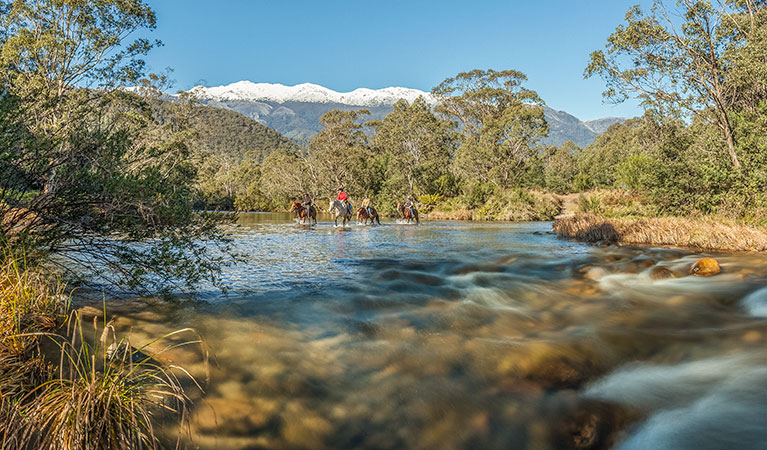National trail: Tom Groggin to Geehi
Khancoban area in Kosciuszko National Park
Overview
Ride, cycle, or hike 21km of National trail in Kosciuszko National Park. Saddle up your horses for a day of high-country adventure on this epic ride from Tom Groggin to Geehi horse camp.
- Where
- Khancoban area in Kosciuszko National Park in Snowy Mountains
- Accessibility
- No wheelchair access
- Distance
- 21km one-way
- Time suggested
- 4-6 hr
- Grade
- Medium
- Trip Intention Form
-
It's a good idea to let someone know where you're going. Fill in a trip intention form to send important details about your trip to your emergency contact.
- Entry fees
- Park entry fees apply
- Opening times
- Open between October and May. Check park alerts and the National trail website for details.
- What to
bring - Drinking water, food supplies, tent, sleeping bag, first aid kit, personal locator beacon, clothes for all weather conditions, hat, sunscreen, raincoat
- Please note
- For detailed information and trail notes, visit the National trail website.
- Horse riders and cyclists must give way to all walkers. Cyclists must give way to horse riders. Read the code of practice for horse riding.
- Remember to secure your horses in the yards at Tom Groggin or Geehi if you’re camping, as brumbies often visit.
- Alpine weather can change rapidly. Pack for extreme heat, as well as strong wind and snow, even in summer.
- Creeks often dry up by late summer so check with NPWS about water before you leave. You may need to bring water for horses.
- Use a topographic map and pack a compass as unexpected detours may be required.
Saddle up for a Man from Snowy River experience in the high country. This section of National trail, also known as Boardman's Run, follows the mighty Murray River and the Alpine Way in parts.
Starting at Tom Groggin, near Thredbo, it's suitable for competent horse riders, keen mountain bikers, and experienced walkers.
As you wind along the trail for 21km you'll encounter steep climbs, creek crossings through ferny valleys, and historic huts to explore. If you have fishing gear, stop to catch a trout in the river, then cook it up on fire rings at the horse camps at either Tom Groggin or Geehi.
Wallabies, wombats, kangaroos, and emus are often easy to spot on the ground in this area. Wedge-tailed eagles, flame-robins, treecreepers, and lyrebirds could be harder to glimpse, so it's worth packing binoculars. In spring the slopes come alive with purple hovea, then yellow and orange peas, while the plains are carpeted with yellow billy buttons and white paper daisies.
National trail is one of Australia’s iconic long-distance treks. It stretches 5330km, from Cooktown in Queensland to Healesville in Victoria and follows the historic coach, horse and stock routes of early European pioneers.
National Trail - Tom Groggin to Geehi
-

Tom Groggin horse camp
Tom Groggin horse camp is the perfect start or end point for a horse riding adventure along the scenic Tom Groggin to Geehi section of National trail, in Kosciuszko National Park.
-

Tom Groggin campground
Tom Groggin campground, between Khancoban and Thredbo, is an ideal base to enjoy fishing, bushwaking, mountain biking, and 4WDing in southern Kosciuszko National Park.
-

Geehi horse camp
Stay at Geehi horse camp, on the Tom Groggin to Geehi section of the National trail, in Kosciuszko National Park. It’s a great place to unsaddle and rest on your horse riding adventure.
Map
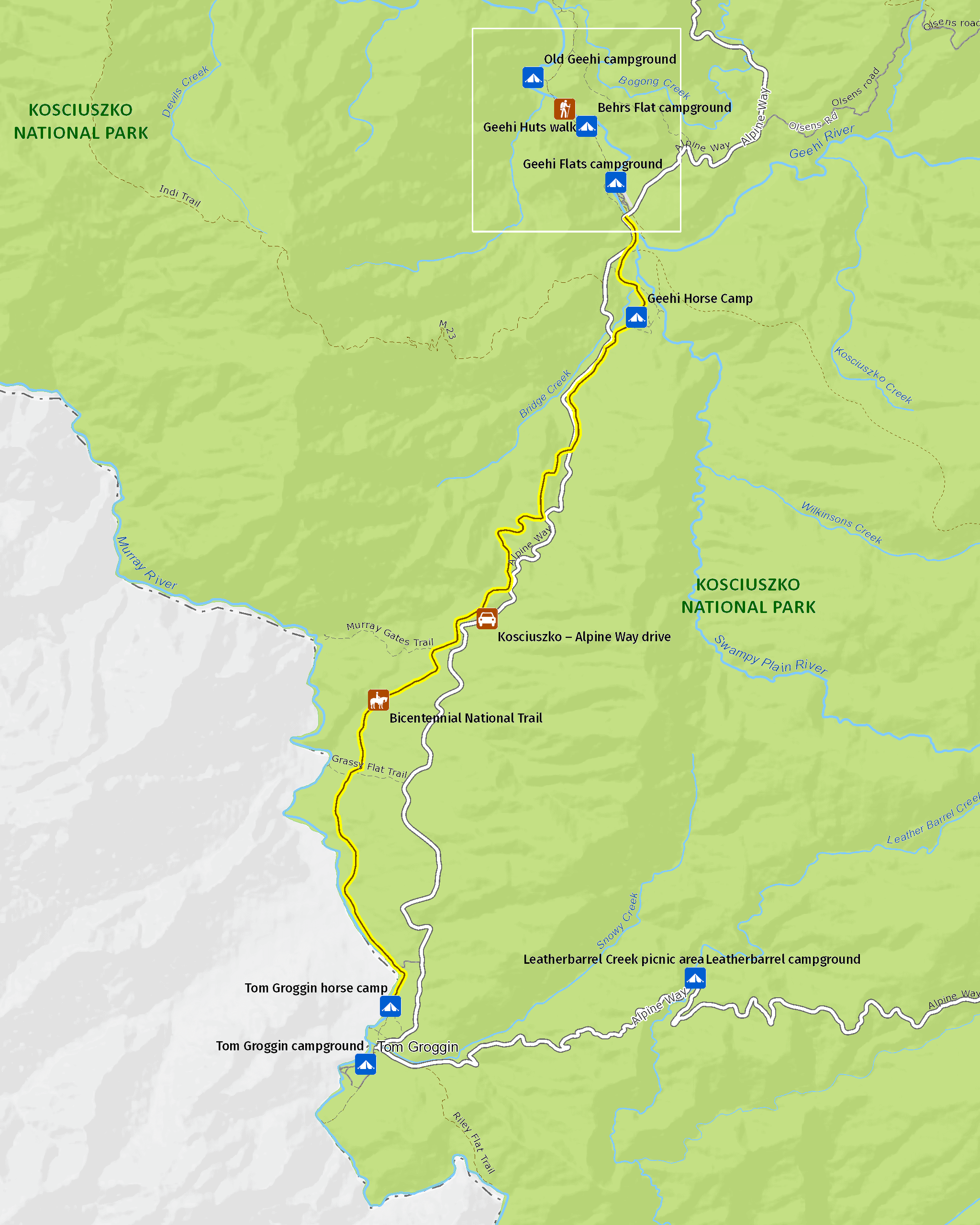
Map
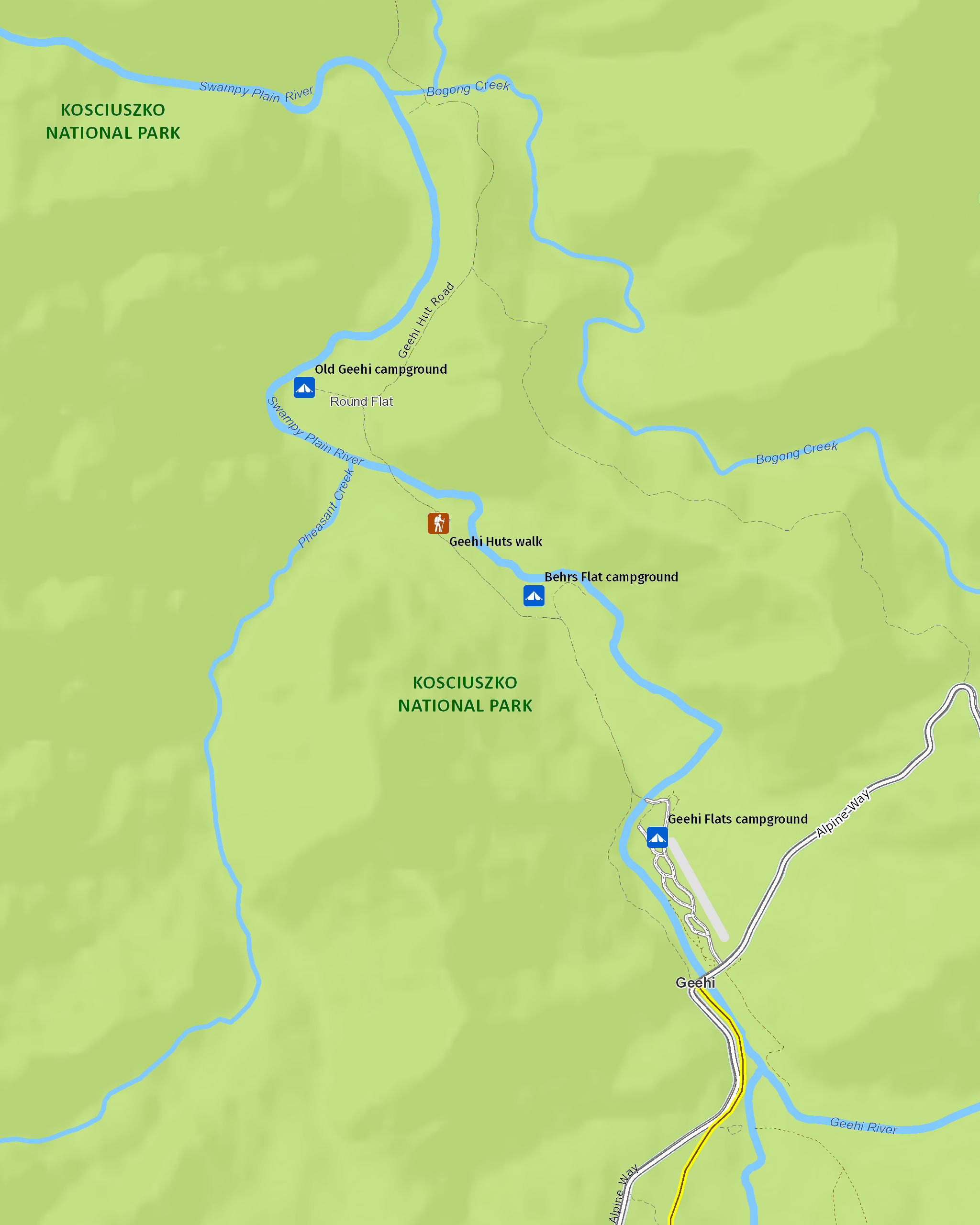
Map legend

Map
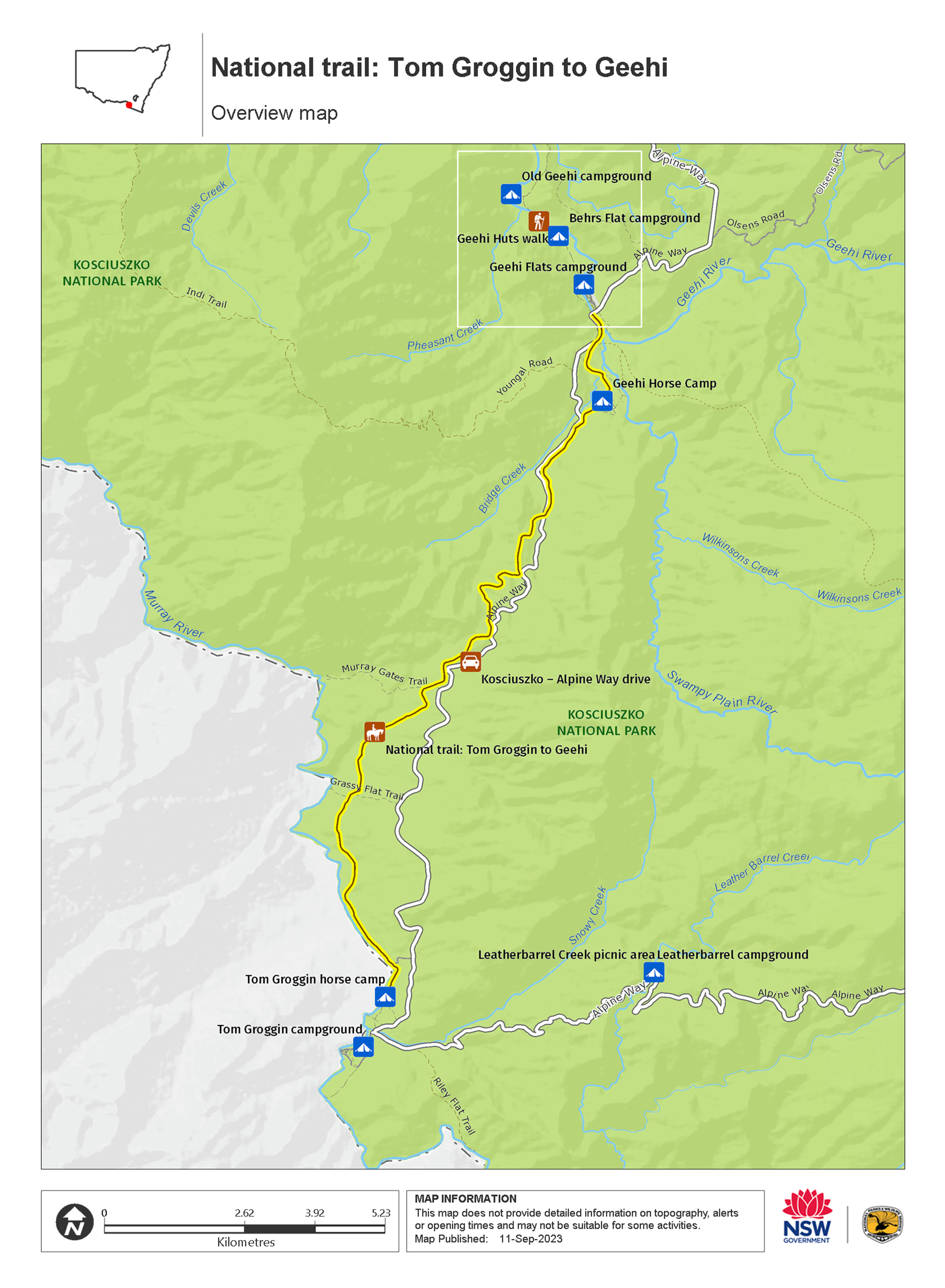
Map

Local alerts
For the latest updates on fires, closures and other alerts in this area, see https://www.nationalparks.nsw.gov.au/things-to-do/horse-riding-trails/national-trail-tom-groggin-to-geehi/local-alerts
General enquiries
- National Parks Contact Centre
- 7am to 7pm daily
- 1300 072 757 (13000 PARKS) for the cost of a local call within Australia excluding mobiles
- parks.info@environment.nsw.gov.au
Park info
- in the Khancoban area of Kosciuszko National Park in the Snowy Mountains region
The Khancoban area is open all year, but access along the Khancoban to Cabramurra Road is closed in winter (June to October long weekends).
-
Park entry fees apply on Alpine Way
Winter (June to October long weekends): $29 per vehicle per day (24hrs from purchase); motorcycles $12; bus passengers $11.45 per adult, $3.60 per child per day. Find out more about the winter entry surcharge.
Rest of Year: $17 per vehicle per day (24hrs); motorcycles $7; bus passengers $6.60 per adult, $2.20 per child per day.
Passes: Single and Multi-Day passes available from Khancoban Visitor Centre's 24-hour vending machines, or via the Park'nPay app.
See vehicle entry fees for other areas in Kosciuszko National Park.
Buy annual pass.
Visitor info
All the practical information you need to know about National trail: Tom Groggin to Geehi.
Maps and downloads
Visitor centre
-
Khancoban Visitor Centre
2 Scammel Street, Khancoban NSW 2642 - Winter (June to September): Open 9am to 4pm Monday to Friday and 10am to 2pm on weekends. Rest of year: Open 9am to 4pm daily. Closed Christmas Day.
- 02 6070 8400
Learn more
National trail: Tom Groggin to Geehi is in Khancoban area. Here are just some of the reasons why this park is special:
Unique landscapes

The Western Fall of Kosciuszko National Park’s Main Range is the highest and steepest part of the Snowy Mountains. Mount Townsend and Abbot Peak block the view to Mount Kosciuszko, but their towering, rocky peaks are a breathtaking backdrop to the Geehi Plains, 1600m below. The mountain range captures the westerly air stream allowing tall mountain ash forest to grow in the moist soil below the treeline.
The man-made landscapes of the Snowy Hydro Scheme, one of the civil engineering wonders of the modern world, are also on show. Murray 1 and 2 Power Stations are close to Khancoban, while the scenic drive to Kiandra travels across the very top of the Tumut Pond Reservoir wall.
- Scammells Ridge lookout Scammells Ridge lookout, 1000m above sea level, offers marvellous views of the rugged Western Fall of the Main Range, and makes a scenic picnic spot just off Alpine Way.
Historic alpine huts

The Khancoban area is home to many of Kosciuszko National Park’s picturesque historic huts. Built as shelter or fishing retreats for graziers and prospectors, or like Major Clews Hut, by Snowy Hydro Scheme workers, the huts provide a window into the past. The 8km return Geehi Huts walk is a great way to see Geehi, Keeble’s and Old Geehi Huts, all constructed from river rocks. Be prepared for several river crossings. Bradleys and O’Brien’s Hut is hard to miss along the Khancoban to Kiandra drive. You can also stretch your legs on a short walk to the rustic Patons Hut or Round Mountain Hut, made out of corrugated iron and surrounded by wilderness.
- Geehi huts walking track Explore Geehi huts walking track by foot, bike, horse or 4WD. This short track, near Khancoban, boasts historic huts, river crossings and magnificent views of the Snowy Mountains in Kosciuszko National Park.
- National trail: Tom Groggin to Geehi Ride, cycle, or hike 21km of National trail in Kosciuszko National Park. Saddle up your horses for a day of high-country adventure on this epic ride from Tom Groggin to Geehi horse camp.
- Round Mountain Hut walking track Round Mountain Hut walking track winds through the Jagungal Wilderness Area in central Kosciuszko National Park. A great Snowy Mountains walk or ride, it offers view and spring wildflowers on its way to the rustic hut.
Discover western and central Kosciuszko
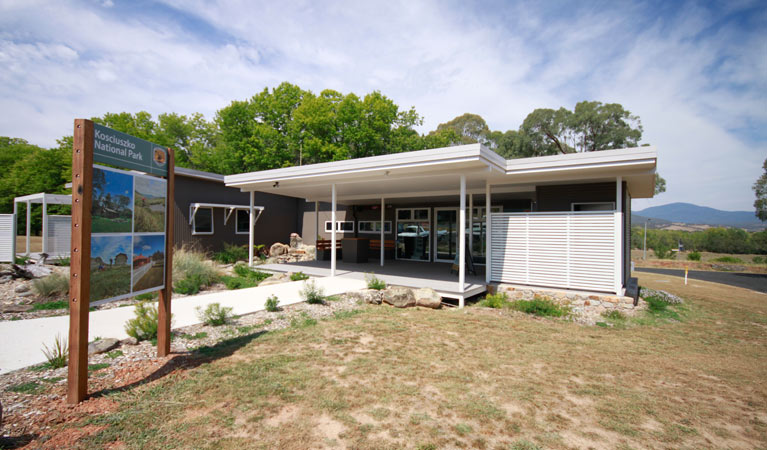
Khancoban Visitor Centre is a convenient stop to buy passes, get maps, information and inspiration before you enter the park. Alpine Way is the main, year-round route through this area. It offers lookouts, campgrounds, picnic areas, walking tracks and bike trails along its 108km length between Khancoban and Jindabyne. The area's upgraded section of the National trail is popular with horse riders, who can also take advantage of horse camps near Geehi and Tom Groggin.
- Khancoban to Kiandra drive Picturesque Khancoban to Kiandra drive links Alpine Way with Snowy Mountains Highway, in Kosciuszko National Park, and takes in scenic dams, historic huts, mountain forest, and the highest town in Australia.
- Khancoban Visitor Centre Khancoban Visitor Centre, on Alpine Way at western entry point to Kosciuszko National Park, is a great place to pick up maps, information and buy a parks pass for your Snowy Mountains adventure.
- Kosciuszko – Alpine Way drive A driving or motorbike tour along Alpine Way scenic drive is a great way to discover the spectacular mountain views, serene campgrounds, magnificent walks, rides, and heritage of southern Kosciuszko National Park.
- National trail: Tom Groggin to Geehi Ride, cycle, or hike 21km of National trail in Kosciuszko National Park. Saddle up your horses for a day of high-country adventure on this epic ride from Tom Groggin to Geehi horse camp.
Remote wilderness and rare species

In recognition of Kosciuszko's unique value as a conservation area, it’s been named a UNESCO Biosphere Reserve. More than half of the park, over 350,000ha (almost 865,000 acres), has been declared wilderness, including the Jagungal, Western Fall and Indi wilderness areas, located in the Khancoban area. The park's alpine and sub-alpine areas are home to rare plant species found nowhere else in the world, such as the Southern corroboree frog.
- 7-day guided horse riding trek with Snowy Wilderness Experience life in the saddle on a 7-day guided horse riding trek with Snowy Wilderness. Explore the stunning mountain scenery of the Khancoban area in Kosciuszko National Park.
- 7-day guided horse riding trek with Snowy Wilderness Experience life in the saddle on a 7-day guided horse riding trek with Snowy Wilderness. Explore the stunning mountain scenery of the Khancoban area in Kosciuszko National Park.
- Round Mountain Hut walking track Round Mountain Hut walking track winds through the Jagungal Wilderness Area in central Kosciuszko National Park. A great Snowy Mountains walk or ride, it offers view and spring wildflowers on its way to the rustic hut.
Plants and animals protected in this park
Animals
-

Spotted tree frog (Litoria spenceri)
The spotted tree frog is a rare Australian frog that lives in only a small number of high mountain streams, including a single location in Kosciuszko National Park. It’s listed as critically endangered in NSW.
-

Bare-nosed wombat (Vombatus ursinus)
A large, squat marsupial, the Australian bare-nosed wombat is a burrowing mammal found in coastal forests and mountain ranges across NSW and Victoria. The only other remaining species of wombat in NSW, the endangered southern hairy-nosed wombat, was considered extinct until relatively recently.
-

Common brushtail possum (Trichosurus vulpecula)
One of the most widespread of Australian tree-dwelling marsupials, the common brushtail possum is found across most of NSW in woodlands, rainforests and urban areas. With strong claws, a prehensile tail and opposable digits, these native Australian animals are well-adapted for life amongst the trees.
-

Common ringtail possum (Pseudocheirus peregrinus)
Commonly found in forests, woodlands and leafy gardens across eastern NSW, the Australian ringtail possum is a tree-dwelling marsupial. With a powerful tail perfectly adapted to grasp objects, it forages in trees for eucalypt leaves, flowers and fruit.
-

Emu (Dromaius novaehollandiae)
The largest of Australian birds, the emu stands up to 2m high and is the second largest bird in the world, after the ostrich. Emus live in pairs or family groups. The male emu incubates and rears the young, which will stay with the adult emus for up to 2 years.
-

Platypus (Ornithorhynchus anatinus)
One of the most fascinating and unusual Australian animals, the duck-billed platypus, along with the echidna, are the only known monotremes, or egg-laying mammals, in existence. The platypus is generally found in permanent river systems and lakes in southern and eastern NSW and east and west of the Great Dividing Range.
-

Short-beaked echidna (Tachyglossus aculeatus)
One of only 2 egg-laying mammals in the world, the short-beaked echidna is one of the most widespread of Australian native animals. Covered in spines, or quills, they’re equipped with a keen sense of smell and a tube-like snout which they use to break apart termite mounds in search of ants.
-

Superb lyrebird (Menura novaehollandiae)
With a complex mimicking call and an elaborate courtship dance to match, the superb lyrebird is one of the most spectacular Australian animals. A bird watching must-see, the superb lyrebird can be found in rainforests and wet woodlands across eastern NSW and Victoria.
-

Swamp wallaby (Wallabia bicolor)
The swamp wallaby, also known as the black wallaby or black pademelon, lives in the dense understorey of rainforests, woodlands and dry sclerophyll forest along eastern Australia. This unique Australian macropod has a dark black-grey coat with a distinctive light-coloured cheek stripe.
Plants
-

Billy buttons (Craspedia spp. )
Billy buttons are attractive Australian native plants that are widespread throughout eastern NSW in dry forest, grassland and alpine regions such as Kosciuszko National Park. The golden-yellow globe-shaped flowers are also known as woollyheads. Related to the daisy, billy buttons are an erect herb growing to a height of 50cm.

